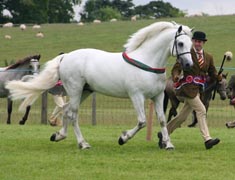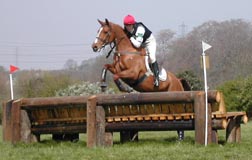| EQUINETOURISM - HORSE BREEDS - The British Connemara |
| British Native Pony Breeds - The Connemara Pony of Ireland |
The highly versatile and talented Connemara pony excels in many disciplines - natural jumpers and excellent all-rounders, they are enjoyed by children and adults alike. Their skills and sure-footedness was learned on the rough and hilly terrain of their native land, where the breed has been carefully managed and its qualities preserved.
|
|
|
| The Connemara |
The Connemara has an excellent overall record in Mountain & Moorland ridden and working hunter pony classes. Connemaras have won the Mountain & Moorland final at Olympia seven times - with up to nine ponies qualifying each year.
Connemara ponies are also successful in Mountain & Moorland working hunter pony classes all over the country, demonstrating their love of jumping and ability to jump with style. They are natural jumpers and excellent all rounders giving pleasure to children and adults at pony and riding club level. Many go on to jump successfully in BSJA affiliated classes.
Their forebears "pulled the cart" in their native land, often for long distances which naturally makes them excellent driving ponies. They are now being used in all branches of this popular sport, from concours d'elegance to cross-country driving. Highly successful in Dressage, the Connemara is an obedient and willing pony who has done well in non-affiliated and affiliated classes and represented both pony and riding clubs in inter-branch finals.
They are also outstanding cross-country performance ponies with the skill and sure-footedness learnt on the rough and hilly terrain of their native land. Many ponies have outstanding record in eventing, reaching pony and riding club finals.
The natural stamina of the Connemara makes them very good long-distance riding ponies and many people are getting pleasure and success out of this popular breed. |
|
|

Current Multi-Champion
Connemara stallion
Bunowen Castle Ri
Above: Photo by Christine Mares
|
   |
| The Pure Bred Connemara Breed Standards |
Characteristics: Good temperament, hardiness and staying power, intelligence and soundness, surefootedness and jumping ability, suitable for child and adult.
Height: 133cms - 148cms high (14.2hh).
Colour: Grey, bay, black, brown, dun, with occasional roan, chestnut, palomino and dark-eyed cream.
Type: Compact, well-balanced riding type with depth, substance and good heart room, standing on short legs covering a lot of ground.
Head: Well-balanced pony head of medium length with good width between large dark kindly eyes. Pony ears, well-defined cheek bones, jaw relatively deep but not coarse.
Front: Head well set onto neck. Chest not over-loaded and neck not set too low. Well defined wither and good sloping shoulder giving a good length of rein.
Body: Deep with strong back. Some length permissible but should be well ribbed up with strong loins.Limbs: Good length and strength in forearm, well-defined knees and short cannons with flat bone measuring 18-21cms. Elbows
should be free, pasterns of medium length, feet well-shaped of medium size, hard and level.
Hindquarters: Strong and muscular with some length, well-developed second thigh and strong low-sethocks.
Movement: Free and true without undue knee action, but active and covering the ground.
Trimming Rules
A good general guideline is that a Connemara should look 'natural but smart'. The pony should be 'in balance', meaning the tail shouldn't be straggly with barely enough hair for a violin bow, while the mane and forelock are like that of a 'Thelwell' pony, and vice versa. Therefore, discreet pulling is acceptable but the pony should still look natural.
Manes - ponies should be shown unplaited. However, very thick manes may be discreetly thinned but should look as natural as possible.
Tails - should look natural and should not but pulled but may be squared off at the bottom.
Head - Ears may be trimmed flat (no trimming inside of the ears). Light trimming of long hairs in jaw line is permitted. Whiskers should not be trimmed.
Legs - No trimming of feather on legs or trimming into heels. No false hair, artificial colouring or make-up should be used.
Clipping: Ridden ponies ONLY may be clipped in the interest of welfare. Legs should not be clipped.
Under no circumstances should foals be clipped.
Freeze Branding: The Society does not object to ponies being freeze branded. This should not be detrimental to animals in the show ring and should be encouraged. |
| Part Bred Connemaras |
The Register is open to all Connemara cross-breds with a minimum of 25% Connemara blood. The thoroughbred cross is particularly successful producing, in many cases, an ideal competition horse with that drop of pony blood to give hardiness, cleverness and jumping ability.
There are many well-known examples of successful competition horses with known Connemara blood:
Dundrum - the legendry Irish show-jumper.
Little Model - outstanding Olympic dressage horse.
Eagle Rock & The Done Thing - advanced Eventers.
Shipton Eblana - International junior show jumper. |
| "The Connemara" - Summary of a feature by Pat Parker |
Reproduced by kind permission of the British Connemara Society
Ponies have existed in the West of Ireland for many centuries and there are plenty of wild and wonderful theories as to their origins, as wild and wonderful as the area they inhabit! However, their history as a definitive breed must start from the first volume of the Connemara Pony Stud Book published in 1926.
How The Connemara Pony Stud Book Was Formed: This was compiled by around thirty - mostly local Connemara gentlemen - who formed themselves into the Connemara Pony Breeders Society with the purpose of selecting a nucleus of ponies from the dwindling number of local mares and promoting them. They agreed that a compact, short legged pony of about 128 cm with good limbs and true and easy movement from the shoulder should be their aim. By selecting the best stallions and persuading the local farmers to only make use of those stallions at a reasonable fee they hoped to promote and improve the Breed. Apart from a raised height limit 14.2 hh (148 cm) this is still the goal most breeders aim for to this day.
History & Heritage: Unfortunately the bone and substance was a little lost along the way, but more recently this important quality and that of the true, free and easy movement is being retrieved both in their native country and in England ,where they are now one of the most sort after ponies for all the family to enjoy. These early ponies were not a 'wild' breed in that large herds did not roam the hill as some of our Native Breeds do in this country. In Connemara they were mostly owned singly by local farmers to work on their smallholdings, carting seaweed from the shore and hay and peat, besides carrying the family to market and to Church. There are plenty of stories of inebriated heads of the family being safely carted home after a good day at the market, without any help and direction from the master! Besides this they were expected to breed a foal each year that could be sold at weaning to provide a little extra income which was much needed in those hard times. I maintain that the ponies position as part of the family, as opposed to running wild and free contributes to their kind and generous temperament, so valued by us all.
Introducing Foreign Blood Into the Connemara Breed: Over the years many people, including The Society members, have introduced 'foreign blood' [in the form of] Arab, Thoroughbred, Welsh, even Hackney to 'improve' the Breed, and it says a great deal for those pioneers that they sorted the hay from the chaff and came up with a recognisable breed. Inspectors were appointed to travel the area and farmers were encouraged to bring their ponies to meeting places where most typical mares were passed and a very few colts selected and retained by the Society so that the best could be eventually placed around Connemara and used for a nominal fee. Only six were deemed worthy in that first year - 1924 - and a further nine in 1925 and these were eventually entered in Vol. 1 of the Stud Book in 1926. Ninety-three mares were also selected and from these small beginnings the Connemara Ponies evolved. Selected foreign blood was still being judiciously introduced even in 1942 when a Thoroughbred named Little Heaven was stood at Oughteraard but limited to forty mares at a fee of £5! His most notable contribution to the Breed was a stallion son Carna Dun - forever immortalised to the general public as being the sire of the phenomenally successful jumper Dundrum. The Carna Dun line is still producing some of our best performance ponies to this day.
The Birth of The British Connemara Society: The earliest Shows were held at Carna but in 1947 a move was made to Clifden where it has been ever since and by a coincidence that year saw the birth of The English Connemara Pony Society [formed by] a band of like-thinking friends, and gradually the number and quality of the ponies being imported improved enough for the National Pony Society to include them as a separate section in their Stud Book - Vol. 25. [Recently, the name of the Society has been changed to The British Connemara Pony Society.]
Both the Irish and British Societies were happily going on their separate ways until the bureaucrats of Europe intervened and demanded that all Connemara Societies must interpret their Rules with the 'parent' Society i.e. The Irish Connemara Pony Breeders Society. Long and protracted meetings took place over several years and in 1988 a draft set of rules were drawn up but were not ratified until 1991 at a Meeting on the eve of the 68th Clifden Show. Our Society was then given approved status by the new International Committee for Connemara Pony Societies (I.C.C.P.S.)
Pat Parker
|
| For More information |
| The British Connemara pony society
The Connemara Pony Breeders Society was founded in Ireland in 1923 with the object of conserving and developing the ponies in the area. Inspections were started to select the best ponies from the existing population for entry into the first volume of the stud book which was published in 1926. This work is still carried out today, with all stock being inspected before acceptance for the stud book. The Society purchased their own stallions who travelled round connemara for the service of ponies at very low fees.The English Connemara Pony Society was founded in 1947 to promote the breed in the british isles. Now the society has 800 members, and the ponies have become extremely popular for both children and adults alike as they excel in so many fields. The name has recently been changed to The British Connemara Pony Society.
British Connemara Pony Society
2 East Green, Bowsden,
Berwick upon Tweed,
Northumberland, TD15 2TJ
Tel/Fax: 01289 388800
Email: [email protected]
www.britishconnemaras.co.uk
Registered Charity No: 262765
Photography supplied with kind permission of The British Connemara Pony Society
|
| How to advertise your Stud, Equestrian Centre, Horse Holiday, Events & Shows & Training etc |
| PLEASE CLICK HERE TO ADVERTISE |
BACK TO EQUINETOURISM.CO.UK WORLDWIDE HORSE HOLIDAYS FRONT PAGE
|
|
Equinetourism.co.uk
Horse riding holidays, equestrian events and shows, horseback vacations, equine directory, good horsemanship, horse holidays, uk and worldwide
 
ADVERTISE on Equinetourism.co.uk - Click here
SEARCH FOR CONTENT ON EQUINETOURISM.CO.UK |
Also see www.EquineTourismCommunity.com and www.EquineTourism.com
email: [email protected] - Telephone 00 44 (0)1643 862785
www.EquineTourism.co.uk is owned by Happy Horses Ltd, Holt Ball, Luccombe, Minehead, Exmoor, Somerset TA24 8SZ
Full worldwide copyright and all rights retained ©2004-2014 ongoing Happy Horses Ltd. Please read our Disclaimer
|
